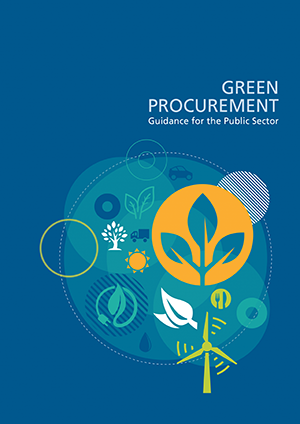Green procurement

eolas takes a look at the guidance offered to the public sector by the Environmental Protection Agency on the issue of green public procurement.
The guidance published by the Environmental Protection Agency is designed to assist the public sector implement and maintain procedures for green public procurement. The guide provides a practical overview of the issues at stake, best practice examples and detailed criteria for insertion in tenders.
Green public procurement (GPP) is defined as a process whereby public and semi-public authorities meet their needs for goods, services, works and utilities by choosing solutions that have a reduced impact on the environment throughout their life-cycle in comparison with alternative products or solutions. The concepts of life-cycle analysis (LCA) and life-cycle costing (LCC) are at the heart of green public procurement and they require buyers and suppliers to consider not just the up-front purchase costs of a given solution, but its total economic and environmental costs from cradle to grave.
Using the example of the purchase of IT equipment of vehicles, the guidance explains how the devices and vehicles that are more energy-efficient often have longer useful life and end-of-life value. In many cases, the guidance states, green public procurement can be read as good public procurement. The report acknowledges that green public procurement can often prove more expensive upfront given the need to invest in innovative materials, production and management processes. However it states that in many areas there are significant opportunities to improve the environmental outcome of purchasing without additional costs or supply chain risks and lists a number of additional benefits of implementing green public procurement, these are:
• recovery – as Ireland continues its economic recovery, SMEs and other businesses are seeking to build their capacity to compete both domestically and abroad. The use of GPP criteria which are built on a common EU framework can help to prepare businesses for public sector tendering requirements in other member states;
 • reputation – the public sector as a whole has a responsibility to display leadership on environmental issues such as climate change, energy and water use;
• reputation – the public sector as a whole has a responsibility to display leadership on environmental issues such as climate change, energy and water use;
• resilience – reducing the dependence on fossil fuels and improving management of energy, water and natural resource has clear long-term economic, social and political benefits.
New directives
New EU directives introduced in 2014 are due to come into force in Ireland by 18th April 2016. The directives will enhance the existing possibilities for green public procurement and provide greater clarity in several areas. These directives include:
• the rejection of abnormally low tenders and exclusion of suppliers who breach this directive where it is due to a breach of certain international social or environmental conditions e.g. on protection of the ozone layer;
• Evidence of environmental management measures which a supplier will be able to apply in the execution of any contract may be requested at the selection stage;
• Award criteria may include social or environmental characteristics of the goods, services or works being purchased e.g. renewable sources or fairly traded products;
• Contracting authorities can refuse to award a contract to the operator submitting the most economically advantageous tender where it does not comply with certain minimum social and environmental obligations set out in Annex X of Directive 2014/14/EU.
Each of these provisions have specific roles attached to them designed to balance the pursuit of environmental objectives with the Treaty principles of transparency, proportionality and free movement/competition. However, with the exception of the abnormally low tenders provision, all provisions will be adopted by authorities on a voluntary basis, they are not mandatory.
Implementation
The guidance notes that public authorities across Europe are implementing green public procurement. In 2012 the centre for European Policy Studies found that 55 per cent of the contracting authorities surveyed had included at least one GPP criterion, with 26 per cent including all of the core green public procurement criteria. This, the advice states, means there is a considerable body of experience to draw upon when considering how to structure and implement green public procurement policy.
While the guidance offered does note that the best approach will depend on the priorities of individual organisations, it claims that adopting green public procurement as a formal policy rather than just an ad-hoc practice signals the commitment to GPP from the highest levels of the organisation and provides a consistent approach that will allow for the ongoing monitoring and improvement of green public procurement results over time.
The advice states that a green public procurement policy should be clear in terms of the scope of the procurement activities covered and how compliance will be monitored and outcomes reported and claims that the criteria should be discussed with existing and potential suppliers in advance of their use in tenders as part of a pre-procurement consultation exercise.
Green Tenders, An Action Plan on Green Public Procurement, identified eight priority sectors for green public procurement implementation in Ireland and set a target for 50 per cent of procurement in these sectors to include at least core green public procurement criteria. However, the guidance document advises those organisations adopting green public procurement for the first time to assess their overall procurement spend and prioritise certain product and service groups in order to reach that target.
The guidance also advises organisations to identify the individuals responsible for implementing, managing and reviewing green public procurement in practice as clear responsibility is vital to effective implementation. Another consideration to bear in mind from the outset is how the progress of GPP will be tracked. Procurement data can be extremely valuable and at a basic level organisations should be able to count the number and value of contracts that include green public procurement criteria.
Improvement
However, in order to drive continuous improvement and effectively target the life-cycle environmental impact and costs of goods and services purchased, a more sophisticated monitoring system will be needed. The guidance claims that many of the contract management clauses inserted in the green public procurement criteria facilitate effective monitoring by placing the burden on the contractors shoulders and as such it is important these clauses are effectively understood and actively reviewed by the contracting authority.
Once the procedures have been agreed upon, reporting can begin. Reporting may take any number of forms, the key, according to the guidance is to ensure that those responsible for the implementation are aware of progress and any areas which need to be improved. Simple communication of progress towards targets should also be complemented by an explanation of any areas where challenges have been encountered.
The strategy believes that both informal and formal feedback from those involved in green public procurement implementation can be useful to assess the overall level of ambition in an organisation’s policy and to identify areas where new targets can be set to drive the next round of implementation and ensure that all levels of green public procurement targets are eventually met.





